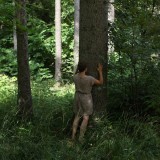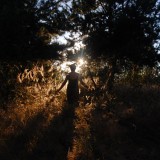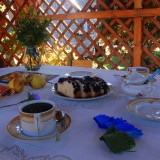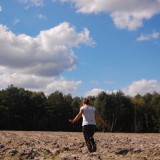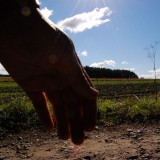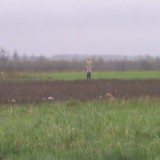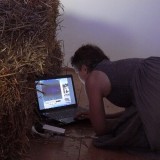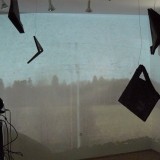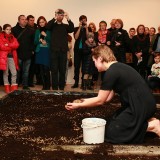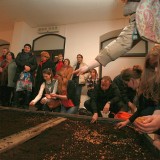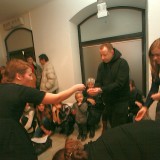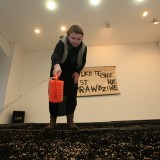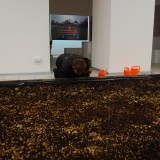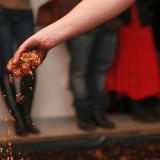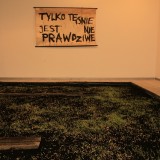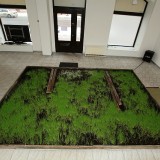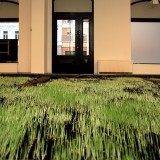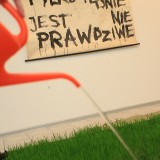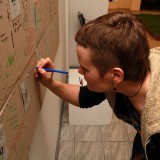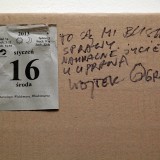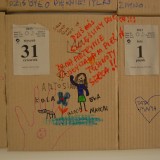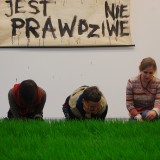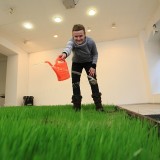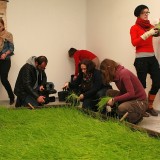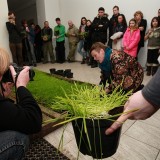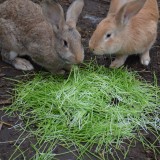Ola Kozioł
It’s the culture – or at least modern Western culture – which leads to divisions in a human being: into a body and psyche, drives and consciousness. A man, divided and insincere in gesture and speech, longs authenticity, to be organic, whole, fulfilled. […]. It’s not about renouncing a part of our nature; everything should have its natural place: body, heart, head, something that is placed »under our feet« and something which is »above our head«. Everything as a vertical line and this verticality should be stretched between on the one hand being organic and being aware on the other. Awareness means consciousness which is not associated with speech (with a thinking machine), but with Presence.
Jerzy Grotowski
She lives in a city, but her field of art is rather reminiscent of folk culture through its contact with nature and the perspective of makind as part of the landscape – inscribed in it and originating from it. It is interesting not only because it contrasts with the urban reality of ŁódĽ and makes an interesting reflection upon postindustrialism, but also because it relates to an interesting, often superseded fragment of identity of this town – most inhabitants came to work in developing factories, eager to hire more workers from the countryside. The world of the countryside was abandoned in favour of a paved promised land. However, the memory of the countryside remained in certain habits and likings and maybe in longings, which in a big city one didn’t want to admit.
Ola Kozioł was born in 1983 in Skierniewice. In 2009 she graudated from the Władysław Strzemiński Academy of Fine Arts in ŁódĽ, from the Department of Graphics and Painting in the studio of Prof. Piotr Stachlewski, where she now works as an assistant professor.
She creates paintings, installations, video and performance but what makes her art unique is connecting traditional visual arts methods with the technique of “white voice” – a technique of singing with an open throat. It is often called a sung scream – as the melody is indeed performed as a scream. This kind of archaic singing, typical for folk singing is characteristic in Eastern Europe: Poland, Ukraine, Belarus and Bulgaria. The piercing voice was created to spread in open spaces or in social situations – to break through the babble of crowded rooms. Ola Kozioł is a member of a group which cultivates the tradition – City Plucking and “The Great Choir of Chorea”. The singing is not just her additional skill. It is associated with given values and sensitivity and through the voice it is brought into art. Apart from references to folk culture it is also a form which evokes the raw expression of a human being, who together with his/her body becomes a resonator and an energy transmitter. It also brings authenticity, searching for and obtaining truth within, reaching for the anthropological sources of gestures or materials. In these areas Ola Kozioł searches for her own spiritual development and connects with them experiences derived from contemporary art, especially performance art.
***
A breakthrough in her artistic practice occured during the exhibition Bread and salt in 2011 in Zb±szyń when for the first time she connected visual art with traditional singing in the video work The field is singing, which was accompanied by a sound element. When she discovered that that activity was is close to her heart, she progressed and applied singing as an essential element of artistic processes.
Experiment with sowing and voice was an artistic action presented in January 2013 in the Manhattan Gallery in ŁódĽ. Grains were increased by the action of watering accompanied by the singing of traditional folk songs (when she was absent, they were played from loudspeakers), giving the viewers the chance for soothing contact with an organic element.
An element of voice also showed up in an action made on her 30th birthday, on April 28th, 2013, entitled Horizon. An existential scream until exhaustion was a question about the borders of human presence in the world, its influence, power and powerlessness. The tie with nature was also underlined in another performance, entitled The song for a tree, conducted during the festival of ephemeral art in Sokołowsko. The artist embraced the trunk of a tree and performed a challenging for listeners, atonal song of Marsyas, expressing with it the pain and suffering present in nature.
The gesture of friendship towards the world was an artistic pilgrimage during her participation in the Art.erie Festival in Częstochowa. The over 150 km pilgrimage route went through villages and small towns. The artist went unaccompanied throughout a 5 day journey and registered her songs on her way. Whilst searching for places to stay she knocked upon strangers’ doors. I feel that this trip has changed me a lot, that I left there everything that was old and unnecessary. It was a time of testing myself and my limits, as well as an attempt to cross them. […] When I was telling stories about the trip I heard a comment: it’s incredible, you slowed down the time; I manage the route – ŁódĽ-Częstochowa in 2 hours and I see nothing and you were walking for 5 days… – she mentioned on her blog.
An interesting use of the power and expression of her voice was revealed in the performance Song from the Workhouse in the Vestry House Museum in London, to which Joanna Rajkowska had invited her. In a building in which there was once a shelter, using a technique of “white voice” which brings associations with the freedom of open spaces, she sang in English about the people who were enclosed there, forced to do strenuous work. She sang about starved children, men and women. The song was played for the entire length of the exhibition, it is also available here:
https://soundcloud.com/olinek/song-from-the-workhouse-vestry%20
***
The art of Ola Kozioł reminds us that art is not only an object that one can collect, sell or buy, but also a process leading towards something to raise or not to raise; a process which takes place in the artist and is transfered to the receiver of his/her work. The reality is this, that which changes inside of us is not only that which is materialistic. “It seems to me that everyone needs to find his/her root, when the reality in which we live is undefined, dynamic, overloaded with information. It would be ideal if I encouraged a search for it” – says the artist. She also comments about her creative process on her blog available at:http://olakoziol.blogspot.com/
Marta Skłodowska


